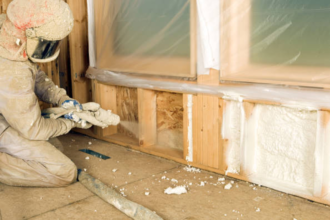Homeowners in the UK are encountering increasing difficulties when selling or remortgaging properties with spray foam insulation. Homes with this kind of insulation in the roof area are not eligible for loans from some of the biggest mortgage lenders in the nation.
- What Is the Problem with Spray Foam Insulation?
- Why Are Lenders Reluctant to Lend Against Homes with Spray Foam?
- How Are Homeowners Being Affected by Spray Foam Insulation Issues?
- What Went Wrong with the Installation of Spray Foam?
- What are the consequences for homeowners of spray foam insulation?
- Why Is There So Much Fear and Confusion Around Spray Foam Insulation?
- What Is the Government Doing to Address This Issue?
- Conclusion: What Does the Future Hold for Homeowners with Spray Foam Insulation?
What Is the Problem with Spray Foam Insulation?
Once promoted as a remedy for excessive energy costs, spray foam insulation creates issues for homeowners trying to sell or refinance. This insulation, frequently put under the Green Homes Grant program, a government program that ran until March 2021, is considered present in 250,000 homes in the UK.
Why Are Lenders Reluctant to Lend Against Homes with Spray Foam?
According to research, 25% of the biggest mortgage lenders in the UK won’t lend money on homes with spray foam insulation. The following significant lenders have declared that they will not lend against properties with spray foam insulation in the roof space: TSB Bank, Principality, Co-operative Bank, Skipton Building Society, and equity release lender Aviva.
Other lenders, including Metro Bank and the Yorkshire Building Society, usually won’t lend on houses with a lot of spray foam. More 2 Life, an equity release provider, would only consider lending on houses containing spray foam if they were part of approved new construction and had the required paperwork.
How Are Homeowners Being Affected by Spray Foam Insulation Issues?
Homeowner Wendy Rowe, whose family has been affected by this problem, described how the difficulties brought on by spray foam insulation took them off guard. “We were blissfully unaware of any issues to do with it until we put the house on the market,” Rowe stated. When the family attempted to sell, they discovered lenders hesitated to approve the mortgage because of the spray foam, even though the property had been insulated under the Green Homes Grant program.
The family was forced to spend a lot of money to remove the foam. “The family has had to pay thousands more for utility bills, surveyors, and estate agents,” Rowe continued. The roof had to be replaced at a cost of about £10,000. Initially covered by the government grant, the installation cost resulted in financial hardship. To proceed with the transaction, Rowe and her family had to divide the expenses with the new purchasers.
What Went Wrong with the Installation of Spray Foam?
Two varieties of spray foam insulation are used to stop heat loss through attics, lofts, and roofs. Rigid closed-cell spray foam has been used to stabilise deteriorating roofs. However, if built incorrectly, it can retain moisture, impede airflow, and increase the danger of roof timber rot.
Although open-cell spray foam is typically more breathable and stays soft after setting, it is sometimes placed over extremely durable underlay materials like bituminous felt, which can trap vapour and cause issues.
The issue is that, despite the possible advantages, the quality of the installation varies. Former Property Care Association (PCA) boss Stephen Hodgson, who currently uses spray foam to check properties, claims that “the work was not up to scratch.” According to Hodgson’s evaluation, a poorly done installation might seriously jeopardise the roof structure.
What are the consequences for homeowners of spray foam insulation?
The problems with spray foam insulation were unanticipated and expensive for homeowners like Gary Wright. Wright discovered that open-cell spray foam had been placed in 2009 at his house, which he had bought years prior, but the installation had yet to be noticed in the acquisition survey. He was shocked to discover that the foam was a significant obstacle to remortgage.
Wright remarked, “I was shocked when I found out,” He clarified that because of the spray foam problem, he felt compelled to extend his mortgage with his present lender at a less advantageous rate. After obtaining multiple costly estimates for expert foam removal, Wright even tried to remove a large portion of the foam himself.
Homeowners are in limbo due to the additional stress these problems have caused. Wright said, “We know that in the next two years, we need to get this fixed, and I can’t afford to right now.” Wright acknowledges that repairs are necessary soon.
Why Is There So Much Fear and Confusion Around Spray Foam Insulation?
The Insulation Manufacturers Association’s Chief Executive, Simon Storer, offered his thoughts on the matter and voiced concern about the ignorance surrounding spray foam insulation. “This phrase ‘spray foam’ has created fear [among lenders] based on a lack of knowledge,” he stated. Additionally, he cited earlier industry advice that was revoked, which might have unnecessarily alarmed homeowners and lenders.
Storer asked for appropriate education on spray foam insulation and underlined that “insulating is a very good thing” when done appropriately. He also urged care about cowboy removal services, frequently promoted through aggressive cold calls, and expressed concerns about unlicensed businesses taking advantage of unsuspecting residents.
What Is the Government Doing to Address This Issue?
According to the Homeowners Alliance (HOA), spray foam insulation should not be installed until the problems with lenders and rogue merchants are fixed. To maintain high standards, the government has guaranteed lenders that any measures implemented under government programs must be carried out by installers registered with Trustmark.
A government representative said, “We have consulted lenders about this matter, who say they rely on the views of valuers and surveyors on this issue.” They went on to say that any installation-related problems should be fixed immediately.
Conclusion: What Does the Future Hold for Homeowners with Spray Foam Insulation?
In the UK, households are experiencing great worry due to the spray foam insulation issue. Many homeowners are left with expensive repairs and continuous financial difficulties due to lenders’ growing reluctance to grant mortgages on homes with this insulation. Homeowners are left hoping for more precise instructions and a resolution as soon as the industry attempts to solve these issues.








